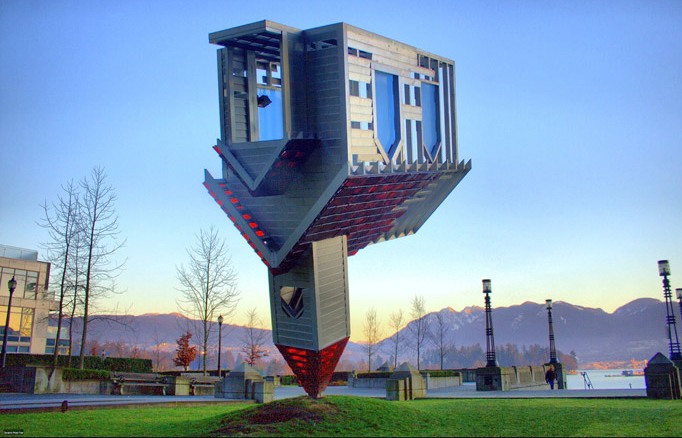Device to Root Out Evil
‘Device to Root Out Evil’ is an upside-down, New England-style church built with its steeple in the ground.
It was created as a sculpture by American artist Dennis Oppenheim. Initially called ‘Church’, it was proposed to New York City’s Public Art Fund, to be located in Church Street, where the artist lived. However, it was considered too controversial and so the name was changed and the sculpture fabricated and installed as part of the 1997 Venice Biennale.
Stanford University approved the purchase of the piece in 2003, but the decision was subsequently vetoed by Stanford’s president who judged it; “inappropriate for campus.” It was later installed in a public park in Vancouver, Canada as part of the Vancouver Sculpture Biennale in 2005, but again was dogged by controversy and was subsequently relocated to the Glenbow Museum in Calgary where it was on display until 2014. It is now in the Plaza de la Puerta de Santa Catalina in Palma, Mallorca.
The 7.5m tall sculpture is fabricated from galvanized steel, perforated metal and Venetian glass.
Oppenheim said of the work; “It's a very simple gesture that's made here, simply turning something upside-down. One is always looking for a basic gesture in sculpture, economy of gesture: it is the simplest, most direct means to a work. Turning something upside-down elicits a reversal of content and pointing a steeple into the ground directs it to hell as opposed to heaven.”
[edit] Related articles on Designing Buildings Wiki
Featured articles and news
Latest Build UK Building Safety Regime explainer published
Key elements in one short, now updated document.
UKGBC launch the UK Climate Resilience Roadmap
First guidance of its kind on direct climate impacts for the built environment and how it can adapt.
CLC Health, Safety and Wellbeing Strategy 2025
Launched by the Minister for Industry to look at fatalities on site, improving mental health and other issues.
One of the most impressive Victorian architects. Book review.
Common Assessment Standard now with building safety
New CAS update now includes mandatory building safety questions.
RTPI leader to become new CIOB Chief Executive Officer
Dr Victoria Hills MRTPI, FICE to take over after Caroline Gumble’s departure.
Social and affordable housing, a long term plan for delivery
The “Delivering a Decade of Renewal for Social and Affordable Housing” strategy sets out future path.
A change to adoptive architecture
Effects of global weather warming on architectural detailing, material choice and human interaction.
The proposed publicly owned and backed subsidiary of Homes England, to facilitate new homes.
How big is the problem and what can we do to mitigate the effects?
Overheating guidance and tools for building designers
A number of cool guides to help with the heat.
The UK's Modern Industrial Strategy: A 10 year plan
Previous consultation criticism, current key elements and general support with some persisting reservations.
Building Safety Regulator reforms
New roles, new staff and a new fast track service pave the way for a single construction regulator.
Architectural Technologist CPDs and Communications
CIAT CPD… and how you can do it!
Cooling centres and cool spaces
Managing extreme heat in cities by directing the public to places for heat stress relief and water sources.
Winter gardens: A brief history and warm variations
Extending the season with glass in different forms and terms.
Restoring Great Yarmouth's Winter Gardens
Transforming one of the least sustainable constructions imaginable.























